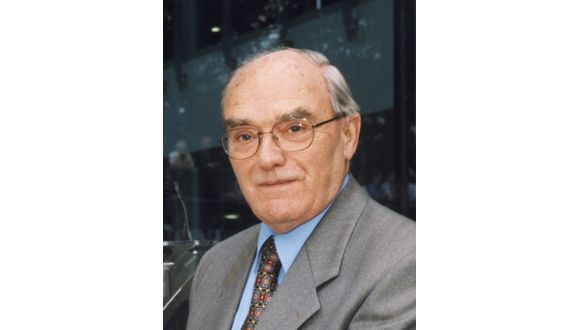Wed, 09 September, 2020
TWI is sad to announce the passing of former Director of Research, Peter Houldcroft on 3 August 2020, aged 97.
Having began his career with aluminium producers James Booth, Peter joined The Institute of Welding’s research arm, the British Welding Research Association (BWRA), where he worked from the London Park Crescent offices. This was where BWRA’s metallurgical research took place and Peter’s early work focused on TIG welding behaviour before moving on to investigate the joint properties of the newly-invented MIG welding method.
This work with MIG welding occurred as it became the favoured process for welding thicker Al alloys, and Peter became a team member of the first UK-based demonstration of an all-welded Al superstructure, which was used for a Thames launch. It was around this time that Peter developed a test to quantify cracking resistance of welded Mg alloys. This test, the Fishbone test, was used for aeroplane fuel tanks and nuclear fuel canisters. He was also at the forefront of a team at BWRA who developed high strength Al alloys for aircraft undercarriages and military bridging.
Peter, along with the London-based Metallurgy Group, moved to Abington near Cambridge in 1956, joining BWRA’s Engineering Department. It was here that Peter proposed that welding research activities were separated from metallurgy and engineering research, and he became the head of the newly-formed Welding Technology Group.
Peter became the Director of Research in 1964, while the early sixties saw him develop what would later become a multi-billion pound industry with his work on laser welding. Having worked with the British Navy and the Services Electronic Research Laboratory (SERL), Peter used his metal cutting expertise to propose the use of coaxially delivered oxygen for the laser cutting of metals. Although the German examining body of the time refused a patent application, the idea and ensuing research would go on to become the worldwide laser cutting industry.
However, this was not the only engineering breakthrough that Peter was involved in as he also directed the build of the world’s first ever 2KW fast axial flow CO2 laser. This became the start of a new era related to the creation of high power gas lasers for welding and cutting metals, which rapidly grew worldwide.
As a result of his contributions to laser technology, Peter was awarded the first ever UK Association of Industrial Laser Users’ medal in 1997, despite it being eleven years after his retirement. Speaking at the time, Peter noted, “It has been 30 years since I invented gas assisted laser cutting at TWI and 11 years since I retired, so I quite expected that the event would have been forgotten.”
Peter’s contributions to TWI were not limited to processes and procedures as he also set up the first integrated Research Board in 1966, which continues to this day. The Research Board still operates to this day, guiding the direction of TWI’s Core Research Programme to ensure it meets the ongoing needs of industry.
Peter’s influence also reached the Institution of Metallurgists, with him becoming President in 1981 before being elected to the Royal Academy of Engineering in 1985. He also wrote many papers and books on welding technology, including ‘Which Process?’ and 'Welding and Cutting - a Guide to Fusion Welding and Associated Cutting Processes' (which was co-authored with Bob John).
Following his retirement from TWI in 1986, Peter wrote a 50 year history of the BWRA/TWI, which was published in 1996 and provides a brilliant record of the early years of the organisation and subsequent growth into an internationally recognised centre of excellence in joining and associated technologies.
Peter’s influence during his career is evident, yet it was also his personality that is worth a mention, as shown by these words from former TWI Director of Research and Technology, Richard Dolby:
“In all my dealings with Peter Houldcroft, he was always polite and kind, an inherently modest man and a mentor and role model to me for many years. Looking back, we had almost identical career paths and we were both fortunate to be able to contribute to an expanding and successful engineering organisation, which was internationally recognised as a centre of excellence. Peter's contribution to laser technology worldwide has been well documented and is a wonderful legacy coming from a long and successful career.”
Peter Houldcroft’s impact on those who met him cannot be denied, as his family rightfully announced, “He was much loved and will be hugely missed.”
